The 25 best gamification rewards (and how to automate them in your community)
Q: How can you encourage your community members to participate—actively and intentionally—in building that thriving community you’ve dreamed of?
To find the answer, we might just have to go back to school:
- M&Ms on the next chapter of the book you need to study.
- Stars on your chart if you raise your hand in class.
Researchers from Pavlov onward have shown that motivation and reward systems are tightly linked, and that we can train our brains to expect that good things follow the right actions.
For example, your body begins to crave the endorphin release that comes after a solid workout.
🕹️ Gamifying your community is an easy, automated way to reward active members, celebrate their contributions, and build a culture of friendly competition.
But which rewards encourage the right actions? In this article, we’ll dig into:
- How gamification can inspire engagement in your community
- Different types of rewards and why they matter
- Tips and things to avoid in gamification
- Plus—25 examples of gamification in action!
Let’s level up!
The benefits of gamification
Gamification taps into two proven levers of human behavior: anticipation and reward.
When members know that a badge, shout‑out, or perk is waiting on the other side of an action, a surge of dopamine nudges them to participate. Repetition turns that nudge into habit until contribution feels natural.
Why rewards matter in gamification
Rewards—points, badges, swag—give members tangible proof that their efforts matter. They transform a passive post‑and‑hope cycle into an active engagement loop:
- Anticipation – Seeing the prize and feeling the itch to earn it.
- Action – Posting, replying, or completing a task that pushes progress forward.
- Feedback – An instant “yes, that counted” confirmation.
- Reward – The payoff that makes the effort worth repeating.
Once members have experienced the internal satisfaction of progress, you can dial down the outward perks to keep them special, reduce admin overhead, and still maintain that momentum.
Why? Because the behavior is now fueling itself.
🏎️ Rewards are the on-ramp. Habits keep the motivation engine running.
How does gamification motivate people?
There are about 5,023,671 theories about motivation in psychology. Even more when you think about the psychological reasons we bond, congregate, befriend, learn, set, and complete goals.
Gamification combines all those internal and external motivations and turns them into a process that you can use to motivate your customers and members to take actions that benefit everyone in the community.
So, how does gamification motivate people?
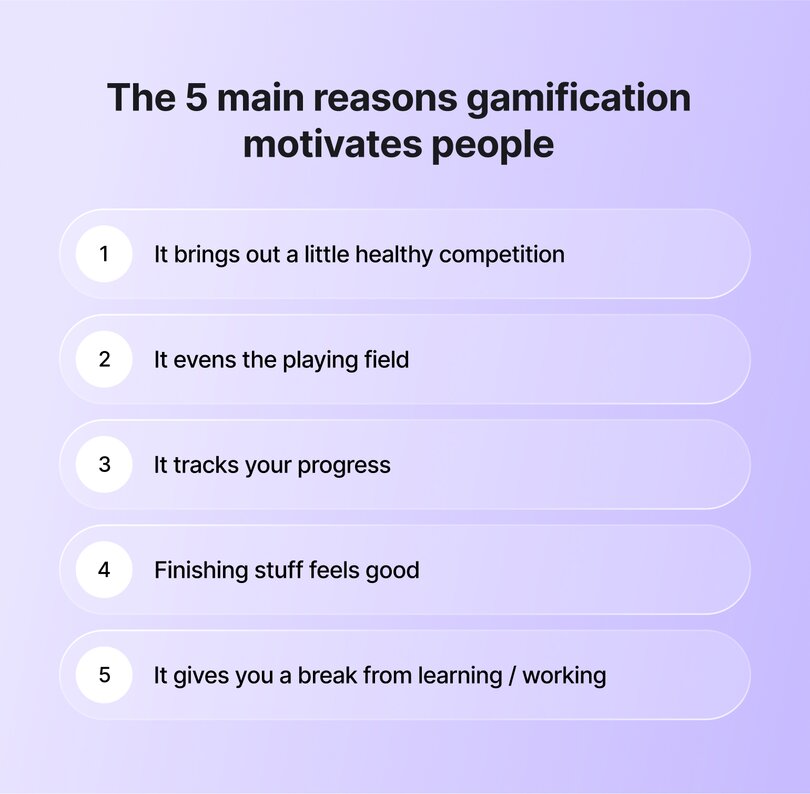
- It brings out a little healthy competition: Remember trying to be the mayor of your local coffee shop on Foursquare? Competition for cool tags, leaderboard positions, or swag drives people to take action.
- It evens the playing field: Introverts, ambiverts, and extroverts are all motivated by similar things—status, recognition, appreciation, and giving. Varying rewards can help encourage quieter folks to contribute more and identify community leaders who might fly under the radar.
- It tracks your progress: If you’re trying to tell me that you haven’t stayed up until 2am finishing that last ultra-hard level before you move onto a new world in Candy Crush, you’re lying, and I don’t want to talk about it.
- Finishing stuff feels good: You know when you sometimes write stuff on your to-do list that you’ve already done that day, just so that you can check it off? Yeah.
- It gives you a break from learning and working: If your community also has a learning or educational component, chatting with peers or contributing to conversations can be a nice way to both reinforce your learning (see: study groups, office hours) and take a mental break (with a little hit of dopamine for your brain!).
Note: some communities may not be a good fit for gamification due to this—think addiction and abuse groups, anonymous communities, etc. And that’s totally okay!
The 5 types of gamification rewards
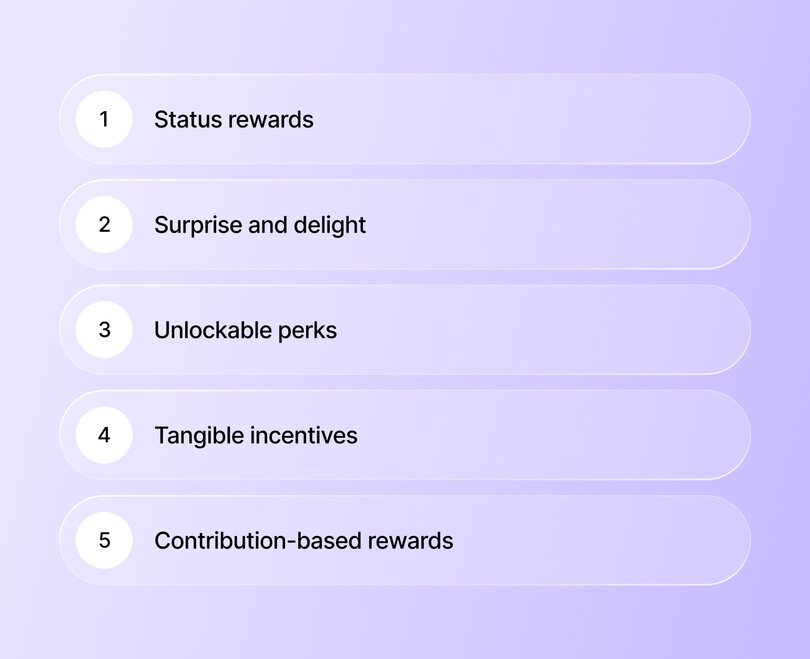
Status rewards
Digital “trophies”, including badges, titles, or ranks, broadcast a member’s expertise or seniority. It could be a title recognizing a member for their prolific forum contributions or a badge for members celebrating their anniversaries as part of your community.
Surprise and delight
Random emoji Easter eggs, flash discount codes, or spontaneous shout‑outs add unpredictability that spark curiosity and keep members returning. A surprise voucher might appear after a milestone post count, or a hidden badge could unlock on a community “holiday.”
Unlockable perks
Private channels, hidden content vaults, or early-access betas let members level up inside the community itself. Picture a strategy library that appears after a seven-day posting streak, or a VIP channel that unlocks once someone posts 100 great answers to questions from their fellow members.
Tangible incentives
Swag may stand for ‘something we all get’, but that does not mean it can’t be exclusive. Limited‑run merchandise, physical mailers, or event passes turn digital effort into something members can hold, wear, or redeem.
👉🏼 Pro tip: Recognizing your top community members with special, branded swag can turn the best member voices into walking testimonials.
Contribution-based rewards
Elevate superfans to co‑creators. Moderator tools, event hosting rights, or spotlight features empower your most engaged members (and hopefully, the ideal type of customer you want more of) to shape the space alongside you.
25 gamification rewards to spark engagement
Over here at Circle HQ, we still believe there’s still huge power in personal touch when it comes to building communities. Many of these reward ideas focus on making folks who engage feel special for doing so—by being personal, intentional, and exclusive.
1. Level‑up cheers
Feel free to do the “boring” thing and personally reach out with a short “hurrah and thank you”, or even record a short video congratulating them!
Better yet—with Circle’s workflows, you can automate this while keeping the authenticity. For example, here’s one for you, Dear Reader.
2. Member‑only discount codes
Any members who naturally contribute to the community are prime candidates for your premium offers. Help them level up (and go deeper into your ecosystem as a result) by offering discounts on your higher-tier offerings, such as memberships, VIP programs, masterminds, or premium courses.
3. One‑to‑one coaching call
If your business includes coaching, offering a 1:1 session helps folks feel seen and appreciated. That appreciation goes a long way towards fostering long-term loyalty.
It also creates a clear link between just how much you value their contributions (since, chances are, your coaching prices are some of your higher-end offerings).
4. Direct‑message access
Your time is valuable, and managing hundreds (or thousands) of direct messages can make community building feel more like a burden. Giving DM access to those who have shown good faith with their membership is an amazing reward to encourage engagement.
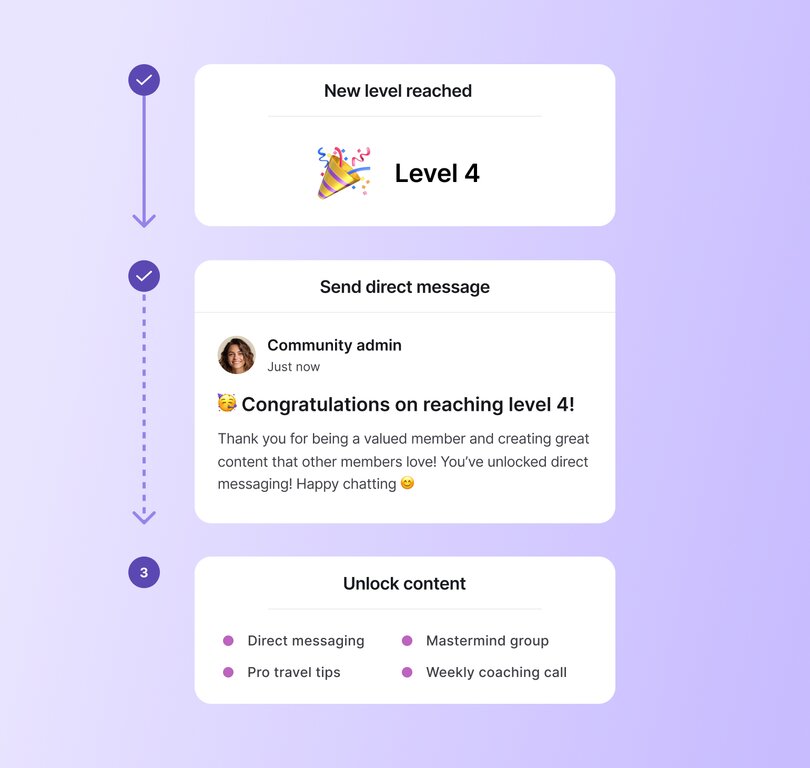
5. Private huddle room
Dave Gerhardt only created a community because of his students’ feedback, which was: we don’t just want to learn from you, we also want to learn from each other.
Joining a space where the most impressive folks from your community hang out? Hell of a reward.
6. VIP roundtable invite
Sometimes, the best reward is rubbing elbows with people you’ve always wanted to meet.
Creating intimate communities—especially of your highly engaged members—can act like a powder keg for your business, and catnip for that top tier.
7. Branded swag drop
Tech companies do it. Musicians do it. TikTok creators do it. Birds and bees do it. (Ok, fine, they don’t.)
All that to say, there’s nothing like saying thank you in the language of gift-giving to make your members feel like part of the crew.

8. Priority Q&A slot
Hitting higher membership tiers can give your members a leg up to get their questions answered by the pros you bring in, or the pro you are.
9. Event or summit discount
Offering discounts to must-attend-events-of-the-season is a surefire way to get in your members’ good graces—no matter whether they’re affiliate event promotions or big-name events you’re throwing yourself.
10. Premium resource vault
Beginner templates are a dime a dozen—but not everybody has access to high-level strategy docs, walkthroughs, or analysis templates. (Or whatever matters to your community members.)
11. Ambassador badge
Once your members reach a certain tier of being extra-awesome, turning them into a promotion partner, or ambassador, is an obvious choice. Because delighted customers make for your strongest marketing.
12. Beta‑tester lane
Getting to test-drive new features before everyone else is one of those rewards that always feels exclusive. Whether that’s gamification (ahem), group coaching, or a new course, your most engaged members are your best testing ground for authentic feedback, while simultaneously making them feel super special.
13. Free taste of paid content
You know when Amazon or Google preview a book for you that you’ve been thinking about buying… and then it cuts off right at the moment you’re getting super into it? A little annoying, to be sure, but man does it create some forward motion (and feel like you got a peek behind the curtain).
14. Direct line to leadership
There’s nothing that’ll make people feel as powerful or important as having a direct line to the King or Queen. (We’re looking at you, Lady Danbury.)
15. Custom flair or title
Whether your gardening group knights someone with a Green Thumb crown, or a Starter Seedling one…
Your tags are your oysters. Love them, honor them, dole them out with care.
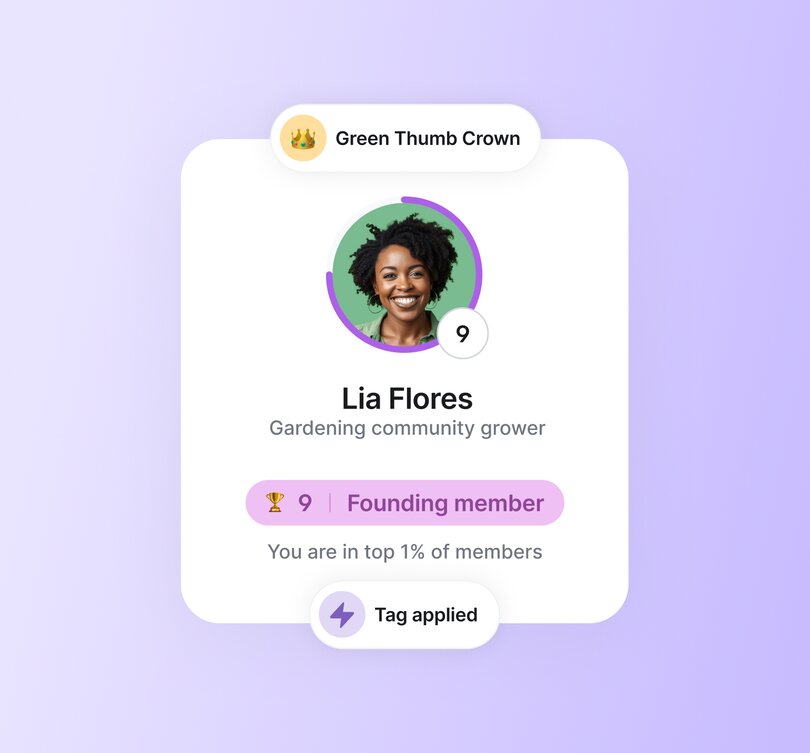
16. Early access to new course
If your community is centered, or includes, an element of education—which most do—then providing early access is something that people will really appreciate. For example, we guarantee you that Codie Sanchez beta-tested and provided early access to her just-launched Main Street Accelerator course to her top members first before launching it publicly.
17. Expert spotlight stage
As your community grows, pulling the golden nuggets from the million amazing conversations becomes harder and harder. That’s why setting up a dedicated space to do so, as well as highlighting some of your top contributors and their areas of expertise works so well as a reward. Because it offers exposure, recognition, and extra cred in the community.
18. Super‑affiliate upgrade
Top online marketing minds Amy Porterfield and Julie Solomon are massive supporters of affiliate marketing—because network marketing is a shortcut for building trust, quickly. You want to reward your biggest spokespeople for talking about you—but how? Help them make more money, too.
19. Host a community meetup
Think of this as both a reward, and a partnership. Your members have their own areas of expertise, knowledge, and community—and combining forces by offering your “stage” can be incredibly beneficial as a marketing tactic, apart from just a show of gratitude.
👉🏼 Pro tip: Member-led communities are built with partnership and reward tactics just like this, and tend to be some of the healthiest and most successful that we see internally at Circle.
20. All‑expenses retreat
Glo Atanmo does intimate get-togethers for her community members—and while this is a project in itself, it can be one of those “make a customer for life” events that pays for itself.
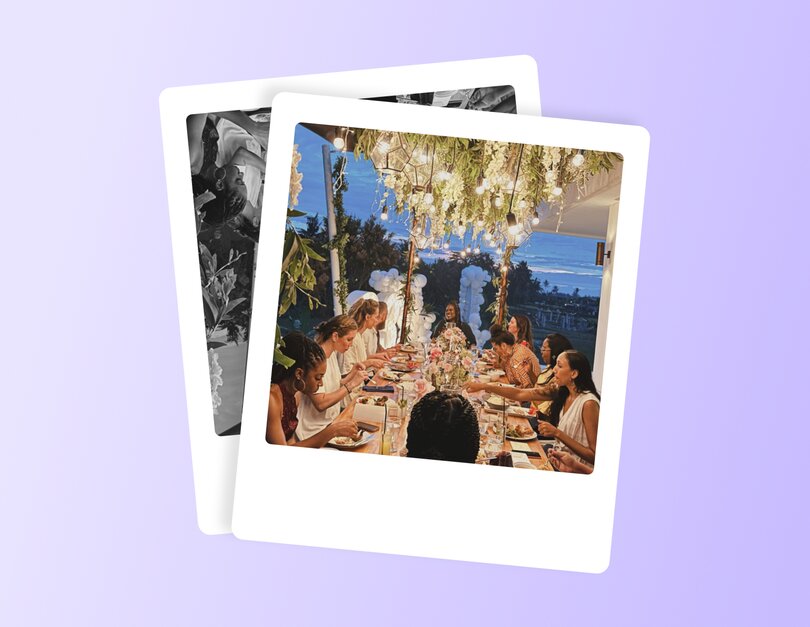
17. Expert spotlight stage
As your community grows, pulling the golden nuggets from the million amazing conversations becomes harder and harder. That’s why setting up a dedicated space to do so, as well as highlighting some of your top contributors and their areas of expertise works so well as a reward. Because it offers exposure, recognition, and extra cred in the community.
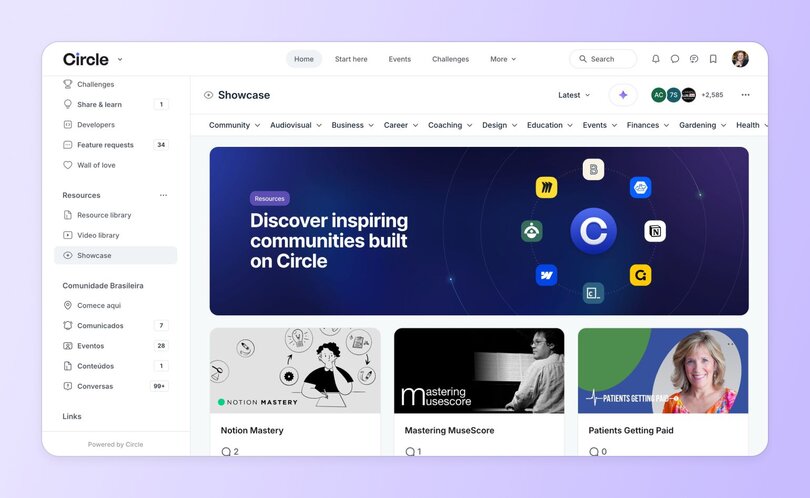
21. Digest shout‑out
I don’t know about you, but I’ve saved all my media, social, and publication mentions—from all time—on my “Hype Board”. It’s what you need to get you out of a funk, or when business is crawling, or when you face a setback. That’s why giving a special shout-out to your biggest cheerleaders could be just the thing that helps them push through the same.
22. Member spotlight post
Your community wouldn’t be as awesome as it is without your members. Roll out a front-page profile complete with their backstory, favorite resources, and a few humblebrag stats. It’s part standing ovation, part networking magnet because nothing sparks new connections like putting a human face on community success.
23. Seasonal challenge badge
Drop a limited-edition “Winter Builder ❄️” or “Summer Star ☀️” badge that vanishes if it’s not earned in four weeks. Scarcity stokes FOMO.
24. Gift-a-friend pass
Create a golden ticket reward like one free month (or course, or tier upgrade) they can hand to a friend. It’s Charlie and the Chocolate Factory meets growth hacking: new member for you, hero status for them, and no one has to get fished out of the chocolate river.
25. Voting power on new features
Upgrade prolific community contributors from the audience to the advisory board by giving their poll votes extra weight. When the next big feature ships, they’ll see their fingerprints all over it and proudly tell the story in every comment thread.
Common problems when designing rewards
Even the flashiest badge can flop if the mechanics behind it miss the mark. Before you roll out your shiny new leaderboard, watch for these classic missteps that drain excitement faster than a phone on 1 per cent.
⚠️ Reward fatigue: Hand out goodies too often and they become background noise, not motivation.
⚠️ Irrelevant prizes: Swag nobody wants lands in the junk drawer (literally or metaphorically) and signals you’re not listening.
⚠️ All-carrot, no purpose: Lean too hard on badges and points and members forget why they’re here; the spark fizzles once the novelty fades.
Best practices for running a gamified rewards program
Done right, gamification feels less like a gimmick and more like rocket fuel for connection. These guidelines keep the engine humming so members stay motivated long after the first badge glow wears off.
✅ Tie rewards to progress, not busywork. Celebrate genuine learning curves and meaningful milestones, not just activity for activity’s sake.
✅ Make it personal. Align perks with member goals or identities so every reward feels hand-picked, not factory-issued.
✅ Blend public kudos with private value. A leaderboard shout-out boosts ego, but a VIP resource link seals loyalty. Use both.
✅ Plan rewards, announce later. Launch with your level structure in place, then unveil perks as members advance. This lets you gauge how many people hit each tier before committing budget, and the mystery keeps curiosity high.
✅ Rotate or sunset perks. Time-boxed badges, seasonal challenges or limited-edition swag keep anticipation high and boredom low.
How to automate your gamification rewards in Circle
Circle’s gamification engine is really a combo-move of tags, segments and workflows. Using tags and segments in a workflow lets you “set it and forget”. Your members are rewarded for their actions and contributions, all while you’re getting some well-deserved rest.
It’s as simple as ⬆️⬆️⬇️⬇️⬅️➡️⬅️➡️🅱️🅰️ (if you know, you know):
- Tag the action. Define triggers such as “posts ten times in #Introductions” or “earns five hundred points.”
- Segment the crowd. Tags flow into smart segments that you set like Newcomers, Mentors, or VIP Lounge, updating automatically as members qualify.
- Trigger the workflow. The workflow reacts to the tag or segment and delivers the reward—a hidden space, an early‑access course, or a shiny badge.
- Add an AI Agent. Train an agent to drop a congratulatory message, answer “How do I level up?” questions, or remind members of unclaimed perks.
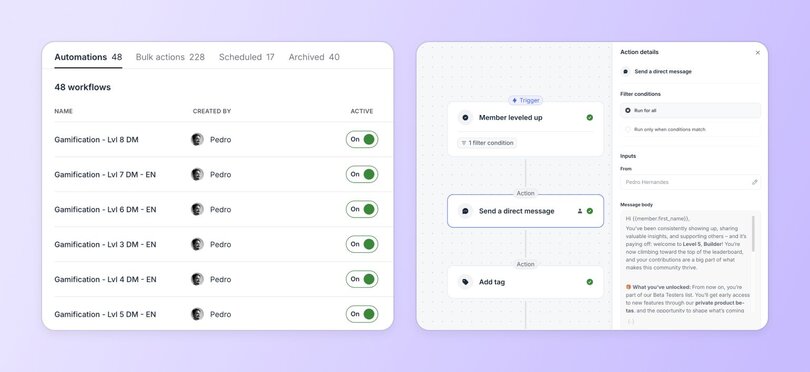
Set it once, then let Circle hand out the high-fives while you focus on guiding the conversations, or scaling your business, or, ideally, both.
Ready to launch your reward program?
The two essentials of a successful gamified system are simple:
👉🏼 Incentivise the actions that make the community stronger, and
🎁 Reward those actions generously.
With Circle’s built-in tags, ranks and workflow automations, you can set those incentives on autopilot and keep members coming back for more.
When you’re ready, dive into Circle’s gamification tools, build your first workflow and watch your leaderboard light up. Here’s a step-by-step gamification guide to get you started.
Common questions about gamification rewards
What are the pros and cons of gamification?
Pros:
- Increases engagement: Rewards drive members to participate regularly by triggering dopamine-driven behavior loops.
- Builds habit: Repetition of rewarded actions turns casual visitors into invested members.
- Boosts motivation: Healthy competition and visible recognition keep community energy high.
- Enhances loyalty: Exclusive perks, coaching calls, and recognition increase member retention and satisfaction.
- Automates retention: Tools like Circle’s workflows allow scalable engagement without constant manual effort.
Cons:
- Reward fatigue: Overuse of perks can dull their impact—members stop caring if everything is rewarded.
- Superficial engagement: Poorly aligned rewards may lead to "busywork" instead of meaningful contributions.
- Incompatibility in sensitive spaces: Gamification may not fit communities focused on addiction, trauma, or anonymity.
- One-size-fits-all failure: Irrelevant or generic rewards signal disconnection from member needs.
Is gamification a loyalty program?
Not exactly, but it can power one.
Gamification is the mechanism—using game-like features such as points, badges, and levels to drive behavior.
A loyalty program is the structure—typically focused on customer retention and repeat purchases.
In communities, gamification can function as a loyalty engine by reinforcing the behaviors that matter (e.g., helping peers, posting regularly), which ultimately builds loyalty. When members feel seen and rewarded, they stay.
How can I gamify loyalty?
To gamify loyalty in your community:
- Tag loyal actions: Identify and tag recurring behaviors (e.g., attending events, posting regularly, sharing knowledge).
- Reward consistency: Offer milestone-based perks like early access, exclusive content, or VIP status.
- Use automation: Circle’s workflows let you trigger rewards based on behavior—like a coaching call after 90 days of activity.
- Blend recognition + value: Public praise (e.g., digest shout-outs) combined with valuable benefits (e.g., premium resources) builds emotional and practical loyalty.
- Create tiers: Loyalty should feel progressive—unlockable perks at each stage of a member’s journey.
What’s an example of bad gamification?
Bad gamification is gamification that feels empty or irrelevant.
For example:
- Giving everyone a badge just for logging in—without any meaningful action.
- Offering swag that doesn’t align with your members' identity or interests.
- Rewarding spammy behavior (e.g., excessive posting just for points), which degrades the community experience.
What are microrewards, and what are their effects?
Microrewards are small, immediate, and frequent reinforcements—like badges, shout-outs, emoji reactions, or level-up messages.
Effects include:
- Instant feedback: Members feel validated right after contributing, which encourages continued engagement.
- Habit formation: Small rewards create anticipation and consistency—core components of behavioral reinforcement.
- Increased dopamine: These “little wins” trigger satisfaction and can hook members into the rhythm of participation.
- Scalable motivation: Easily automated in Circle, microrewards allow creators to reward thousands without manual work.